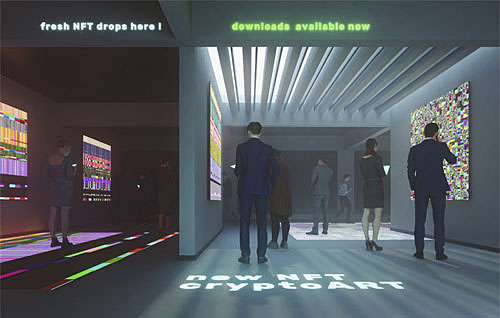The role of institutions, such as Christie’s auction house, has added validity to the emerging NFT world, not to mention that Beeple’s (actually Mike Winkelman) “Everydays” artwork was the third-most expensive work ever sold by a living artist.
“This young industry is closely followed by global companies,” explains NonFungible.com, which tracks the NFT entry of media, financial and entertainment firms — ranging from Major League Baseball to videogame publishers to attire companies like Nike. Its report emphasizes, it is vital “to understand the forces that are driving the development.”
Nonetheless, the digital volatility has attracted some of the biggest names in technology finance to NFTs. Peter Thiel’s Founders Fund is a sizeable investor in OpenSeas, the largest NFT marketplace. The Winklevoss twins own Nifty Gateway, another NFT market.
The shock and awe of the NFT value frenzy has also forced creators, sellers, buyers and intermediaries to explore the array of factors that accompany a new tech product that involves intellectual property, financial and investment issues, regulatory and legislative oversight (for copyright, global trade plus more) and even environmental impact — not to mention aesthetic controversies surrounding the “digital ephemera” as the New York Times called it.
As media attention has accelerated, fueled by the sums being paid for intangible collectibles, some critics scoffed that NFTs images, music performances and sports clips are easily accessible in other digital forms at low or no cost. That criticism overlooks the reality: NFTs are about “ownership.” It’s hard for some observers to grasp that an intangible item can have the same worth as something you can hold in your hands. NFTs are demonstrably unique, thanks to their blockchain coding, hence they have distinct value, even though other collectors may have access to a similar item.
It’s easy to understand that an original Monet can sell for hundreds of millions of dollars, while a high-quality reproduction costs a hundred dollars at a museum shop or a poster reproduction of the same image costs less than $10. Each version brings joy commensurate with what was spent.
Eventually, the blockchain technology and crypto-economics will extend to the physical world.Raullen Chai, co-founder and CEO of IoTeX

NFTs represent the next step in the digital transformation and perception of “value” and “worth.” They represent assets in digital artworks, music, in-game items and other virtual collectibles and are an offshoot of the cryptocurrency upturn during the pandemic.
“Art has been an asset of the wealthy for centuries,” says Seth Shapiro, founder and CEO of Artaku Corp. “Now there is a worldwide cadre of investors who bought Bitcoin or Ethereum, so it makes perfect sense for people who have accumulated wealth in the digital world to acquire digital art.” Shapiro says the pandemic “has accelerated the mind shift,” fueling the passion for digital content. He believes it is “one of the trends driving the uptick,” and calls it an extension of the passion for collectibles, which has moved from the physical world into the intangible realm.
NFTs also represent a new avenue for artist payment, enabling creators and performers to receive revenue each time their creation changes hands, presumably at higher prices. Thanks to the blockchain’s ability to keep track of ownership transfers (and related data), the artist can profit from each sale of the original work, whether or not it is a big hit.
“We have an entire generation that spends its life on digital devices. The next generation of art, collectibles and merchandise should be digital because that’s what this generation uses,” says Shapiro of Artaku, the Austin firm whose name is a play on the Japanese term for “super-fan.” Shapiro sees NFT as a way to bring blockchain technology to the traditional media business. When he spent time in Asia, he recognized the importance of K-pop in Korea as manifested in fan engagement for performers such as BTS and the Japanese concept of Otaku, in which serious fans become experts.
Shapiro, who started his career as a music producer, puts an historical perspective on the value of NFTs, which allows collectors to capture a specific moment in a creative progression. NFTs, he says, “create a time capsule of digital content about how a producer lived and produced a specific work or performance.”
Shapiro contends that NFTs are the next transformation in the digital business model. When the media industry adopted Internet Protocol (IP) for production and distribution, it easily enabled consumers to make copies of copies, “which upended all business, creating a huge shift,” he says. “Bitcoin was so transformational because of its underlying basis: the idea of digital scarcity,” which was the first response to the massive IP ability of “endless reproduceable copies.”
Shapiro says “NFTs are a global game-changer,” and acknowledges the category is “so transformational that we don’t have a name for it yet.” Like others, he expects that NFT is just a stake-holding term until the industry finds a better way of describing this new business.
NFTs are a global game-changer.Seth Shapiro, Artaku
The National Basketball Association’s Top Shot debuted last October, offering “Moments,” virtual video trading cards formatted into a standardized cube-like layout. Within five months, Top Shot — co-developed with NFT pioneer Dapper Labs — reached more than 100,000 buyers and nearly $250 million in sales, with most of its sales transacted in the peer-to-peer marketplace and the NBA taking a royalty on every sale.
Peter Hirshberg, chairman and co-founder of Gray Area, a San Francisco art and technology organization, relishes the arrival of NFTs — with all its challenges. He calls NFT “the 5th generation of machine-based art.”
“They are freaking out the art establishment, particularly the digital art world, he says, noting that NFTs lets artists sell directly to their collectors or stage an open edition auction without using traditional galleries. “They might generate more attention and value in a week than [a gallery] would in a year” and to a global community at lower cost. Hirshberg cites the “immutable provenance, unique work and super distribution characteristics of NFTs” as “a fundamental breakthrough” that is ushering in a new generation of artists and experimentation.”
“They are busting orthodoxy,” Hirshberg adds. “What could be more perfect? Warhol’s factory meets the cloud in 2021.”
“Eventually, the blockchain technology and crypto economics will extend to the physical world,” explains Raullen Chai, co-founder and CEO of IoTeX, a startup focused on building the “infrastructure and proper economics to connect the physical world with the virtual world in a verifiable way.”
Chai cites Pebble hardware that captures and signs data immediately using 16 onboard sensors, while the blockchain and smart contract can verify the signed data and can, for example, mint NFTs according to the application's needs. He points to PebbleGo as the “world’s first decentralized location-based DApp [decentralized applications] that allows users to generate NFT cards for a specific geofence and a particular time.” IoTeX, a CTA member, debuted PebbleGo in May.
“It is the first of its kind showing how the physical world and crypto world can be connected using IoTeX's blockchain and trusted hardware,” Chai says. He expects it will be used to create NFTs that will tokenize ownerships of droids, electric vehicles, and any smart devices that can potentially generate value.”

I3, the flagship magazine from the Consumer Technology Association (CTA)®, focuses on innovation in technology, policy and business as well as the entrepreneurs, industry leaders and startups that grow the consumer technology industry. Subscriptions to i3 are available free to qualified participants in the consumer electronics industry.